Retirement Investment Plan: Defined vs. Investment Choice
VerifiedAdded on 2021/06/17
|9
|2668
|35
Report
AI Summary
This report provides a comprehensive analysis of retirement investment plans in Australia, focusing on two primary options: defined benefit plans and investment choice plans. It delves into the specifics of each plan, outlining their features, advantages, and disadvantages. The report explores key factors to consider when making retirement investment decisions, including the impact of inflation, time value of money, and taxation. It examines the Australian superannuation system, emphasizing its non-contributory nature and the eligibility criteria. The report also touches upon the Future Fund Act and its role in supporting the retirement investment landscape. By comparing and contrasting the two main investment options, the report aims to provide a clear understanding of the complexities involved in retirement planning and assist individuals in making informed decisions. It highlights the importance of considering personal financial objectives and risk profiles when choosing a suitable retirement investment plan. The report concludes with a discussion on the importance of upfront government-sponsored retirement plans.

RETIREMENT INVESTMENT PLAN
Paraphrase This Document
Need a fresh take? Get an instant paraphrase of this document with our AI Paraphraser
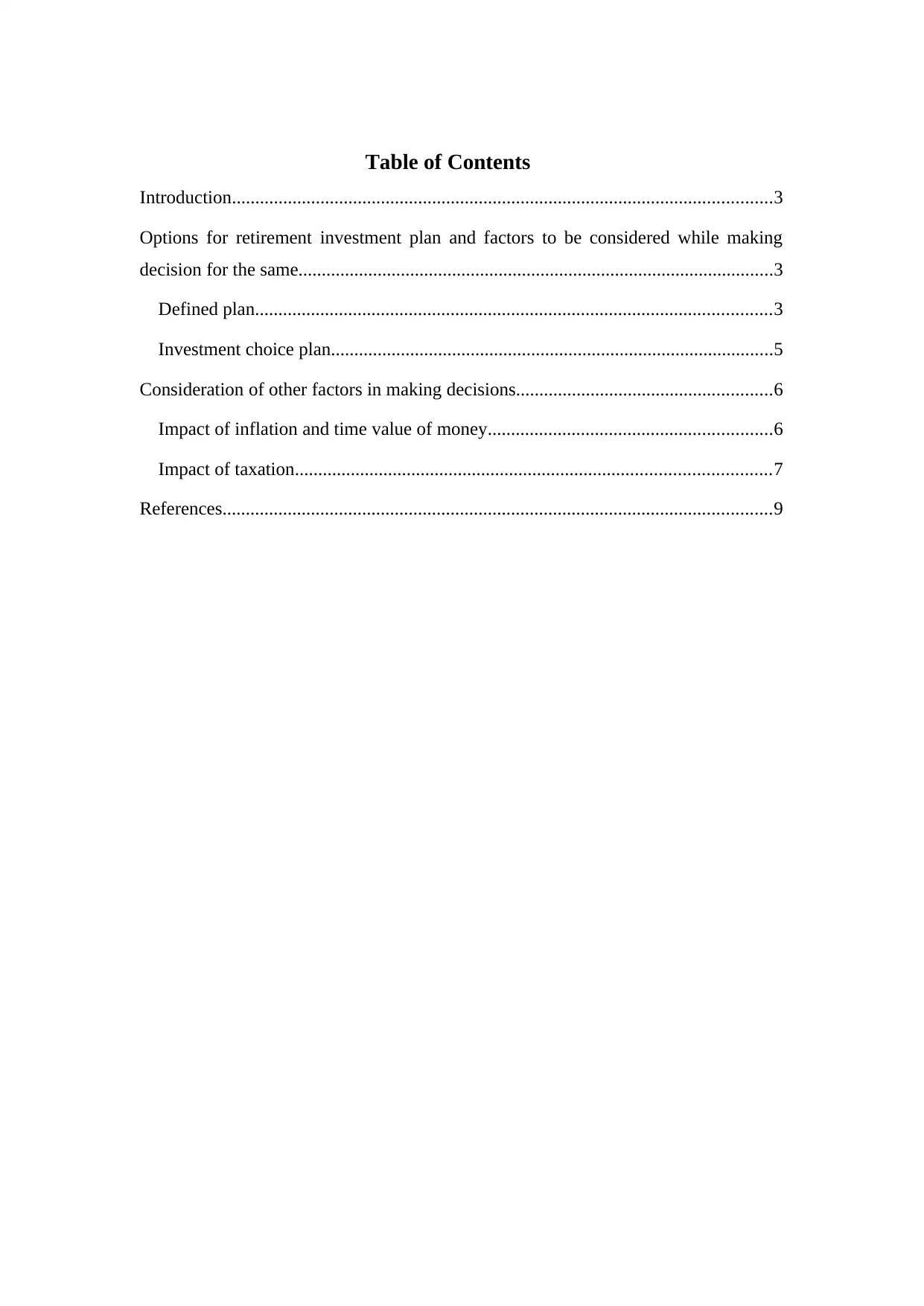
Table of Contents
Introduction....................................................................................................................3
Options for retirement investment plan and factors to be considered while making
decision for the same......................................................................................................3
Defined plan...............................................................................................................3
Investment choice plan...............................................................................................5
Consideration of other factors in making decisions.......................................................6
Impact of inflation and time value of money.............................................................6
Impact of taxation......................................................................................................7
References......................................................................................................................9
Introduction....................................................................................................................3
Options for retirement investment plan and factors to be considered while making
decision for the same......................................................................................................3
Defined plan...............................................................................................................3
Investment choice plan...............................................................................................5
Consideration of other factors in making decisions.......................................................6
Impact of inflation and time value of money.............................................................6
Impact of taxation......................................................................................................7
References......................................................................................................................9
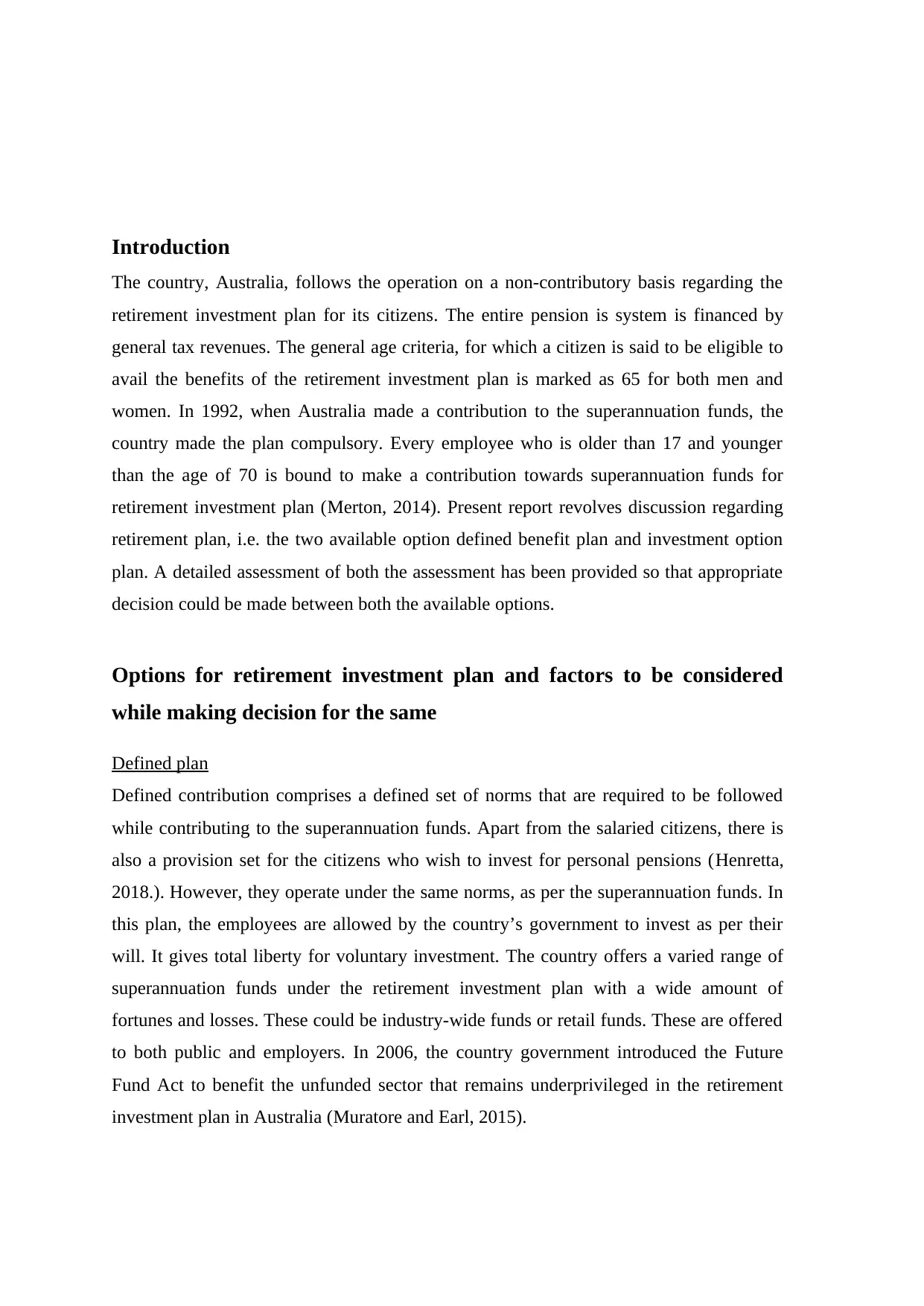
Introduction
The country, Australia, follows the operation on a non-contributory basis regarding the
retirement investment plan for its citizens. The entire pension is system is financed by
general tax revenues. The general age criteria, for which a citizen is said to be eligible to
avail the benefits of the retirement investment plan is marked as 65 for both men and
women. In 1992, when Australia made a contribution to the superannuation funds, the
country made the plan compulsory. Every employee who is older than 17 and younger
than the age of 70 is bound to make a contribution towards superannuation funds for
retirement investment plan (Merton, 2014). Present report revolves discussion regarding
retirement plan, i.e. the two available option defined benefit plan and investment option
plan. A detailed assessment of both the assessment has been provided so that appropriate
decision could be made between both the available options.
Options for retirement investment plan and factors to be considered
while making decision for the same
Defined plan
Defined contribution comprises a defined set of norms that are required to be followed
while contributing to the superannuation funds. Apart from the salaried citizens, there is
also a provision set for the citizens who wish to invest for personal pensions (Henretta,
2018.). However, they operate under the same norms, as per the superannuation funds. In
this plan, the employees are allowed by the country’s government to invest as per their
will. It gives total liberty for voluntary investment. The country offers a varied range of
superannuation funds under the retirement investment plan with a wide amount of
fortunes and losses. These could be industry-wide funds or retail funds. These are offered
to both public and employers. In 2006, the country government introduced the Future
Fund Act to benefit the unfunded sector that remains underprivileged in the retirement
investment plan in Australia (Muratore and Earl, 2015).
The country, Australia, follows the operation on a non-contributory basis regarding the
retirement investment plan for its citizens. The entire pension is system is financed by
general tax revenues. The general age criteria, for which a citizen is said to be eligible to
avail the benefits of the retirement investment plan is marked as 65 for both men and
women. In 1992, when Australia made a contribution to the superannuation funds, the
country made the plan compulsory. Every employee who is older than 17 and younger
than the age of 70 is bound to make a contribution towards superannuation funds for
retirement investment plan (Merton, 2014). Present report revolves discussion regarding
retirement plan, i.e. the two available option defined benefit plan and investment option
plan. A detailed assessment of both the assessment has been provided so that appropriate
decision could be made between both the available options.
Options for retirement investment plan and factors to be considered
while making decision for the same
Defined plan
Defined contribution comprises a defined set of norms that are required to be followed
while contributing to the superannuation funds. Apart from the salaried citizens, there is
also a provision set for the citizens who wish to invest for personal pensions (Henretta,
2018.). However, they operate under the same norms, as per the superannuation funds. In
this plan, the employees are allowed by the country’s government to invest as per their
will. It gives total liberty for voluntary investment. The country offers a varied range of
superannuation funds under the retirement investment plan with a wide amount of
fortunes and losses. These could be industry-wide funds or retail funds. These are offered
to both public and employers. In 2006, the country government introduced the Future
Fund Act to benefit the unfunded sector that remains underprivileged in the retirement
investment plan in Australia (Muratore and Earl, 2015).
⊘ This is a preview!⊘
Do you want full access?
Subscribe today to unlock all pages.

Trusted by 1+ million students worldwide
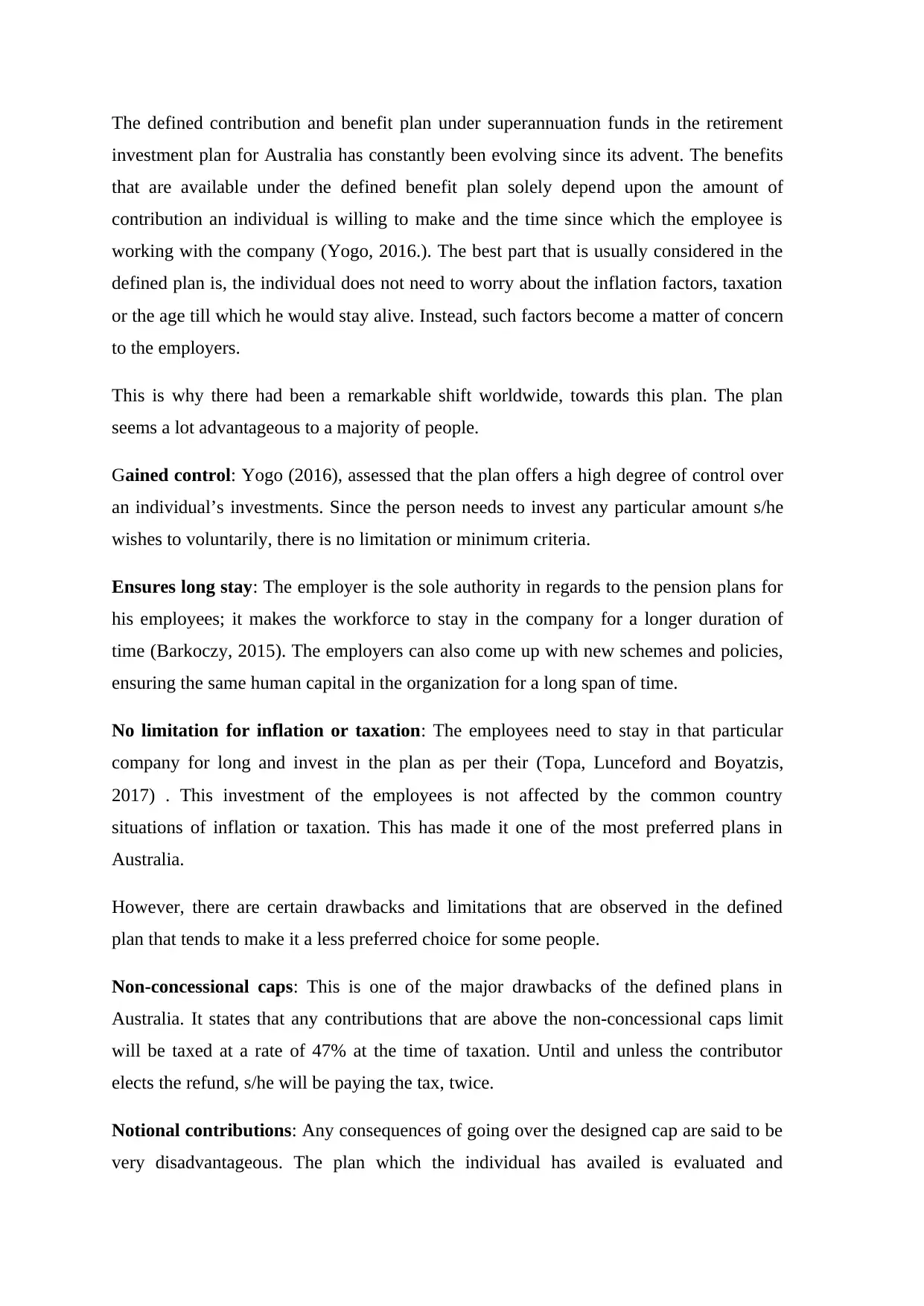
The defined contribution and benefit plan under superannuation funds in the retirement
investment plan for Australia has constantly been evolving since its advent. The benefits
that are available under the defined benefit plan solely depend upon the amount of
contribution an individual is willing to make and the time since which the employee is
working with the company (Yogo, 2016.). The best part that is usually considered in the
defined plan is, the individual does not need to worry about the inflation factors, taxation
or the age till which he would stay alive. Instead, such factors become a matter of concern
to the employers.
This is why there had been a remarkable shift worldwide, towards this plan. The plan
seems a lot advantageous to a majority of people.
Gained control: Yogo (2016), assessed that the plan offers a high degree of control over
an individual’s investments. Since the person needs to invest any particular amount s/he
wishes to voluntarily, there is no limitation or minimum criteria.
Ensures long stay: The employer is the sole authority in regards to the pension plans for
his employees; it makes the workforce to stay in the company for a longer duration of
time (Barkoczy, 2015). The employers can also come up with new schemes and policies,
ensuring the same human capital in the organization for a long span of time.
No limitation for inflation or taxation: The employees need to stay in that particular
company for long and invest in the plan as per their (Topa, Lunceford and Boyatzis,
2017) . This investment of the employees is not affected by the common country
situations of inflation or taxation. This has made it one of the most preferred plans in
Australia.
However, there are certain drawbacks and limitations that are observed in the defined
plan that tends to make it a less preferred choice for some people.
Non-concessional caps: This is one of the major drawbacks of the defined plans in
Australia. It states that any contributions that are above the non-concessional caps limit
will be taxed at a rate of 47% at the time of taxation. Until and unless the contributor
elects the refund, s/he will be paying the tax, twice.
Notional contributions: Any consequences of going over the designed cap are said to be
very disadvantageous. The plan which the individual has availed is evaluated and
investment plan for Australia has constantly been evolving since its advent. The benefits
that are available under the defined benefit plan solely depend upon the amount of
contribution an individual is willing to make and the time since which the employee is
working with the company (Yogo, 2016.). The best part that is usually considered in the
defined plan is, the individual does not need to worry about the inflation factors, taxation
or the age till which he would stay alive. Instead, such factors become a matter of concern
to the employers.
This is why there had been a remarkable shift worldwide, towards this plan. The plan
seems a lot advantageous to a majority of people.
Gained control: Yogo (2016), assessed that the plan offers a high degree of control over
an individual’s investments. Since the person needs to invest any particular amount s/he
wishes to voluntarily, there is no limitation or minimum criteria.
Ensures long stay: The employer is the sole authority in regards to the pension plans for
his employees; it makes the workforce to stay in the company for a longer duration of
time (Barkoczy, 2015). The employers can also come up with new schemes and policies,
ensuring the same human capital in the organization for a long span of time.
No limitation for inflation or taxation: The employees need to stay in that particular
company for long and invest in the plan as per their (Topa, Lunceford and Boyatzis,
2017) . This investment of the employees is not affected by the common country
situations of inflation or taxation. This has made it one of the most preferred plans in
Australia.
However, there are certain drawbacks and limitations that are observed in the defined
plan that tends to make it a less preferred choice for some people.
Non-concessional caps: This is one of the major drawbacks of the defined plans in
Australia. It states that any contributions that are above the non-concessional caps limit
will be taxed at a rate of 47% at the time of taxation. Until and unless the contributor
elects the refund, s/he will be paying the tax, twice.
Notional contributions: Any consequences of going over the designed cap are said to be
very disadvantageous. The plan which the individual has availed is evaluated and
Paraphrase This Document
Need a fresh take? Get an instant paraphrase of this document with our AI Paraphraser
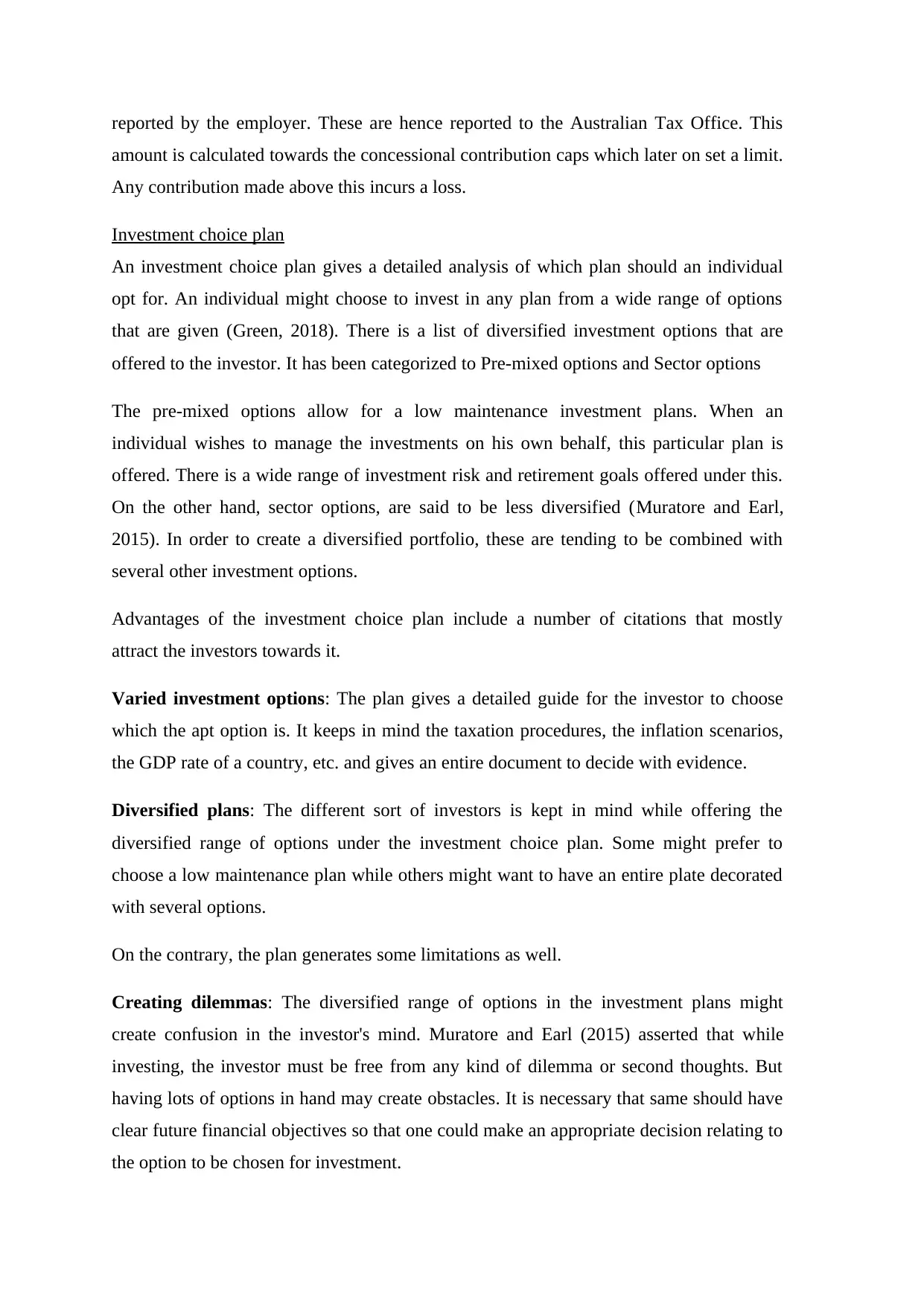
reported by the employer. These are hence reported to the Australian Tax Office. This
amount is calculated towards the concessional contribution caps which later on set a limit.
Any contribution made above this incurs a loss.
Investment choice plan
An investment choice plan gives a detailed analysis of which plan should an individual
opt for. An individual might choose to invest in any plan from a wide range of options
that are given (Green, 2018). There is a list of diversified investment options that are
offered to the investor. It has been categorized to Pre-mixed options and Sector options
The pre-mixed options allow for a low maintenance investment plans. When an
individual wishes to manage the investments on his own behalf, this particular plan is
offered. There is a wide range of investment risk and retirement goals offered under this.
On the other hand, sector options, are said to be less diversified (Muratore and Earl,
2015). In order to create a diversified portfolio, these are tending to be combined with
several other investment options.
Advantages of the investment choice plan include a number of citations that mostly
attract the investors towards it.
Varied investment options: The plan gives a detailed guide for the investor to choose
which the apt option is. It keeps in mind the taxation procedures, the inflation scenarios,
the GDP rate of a country, etc. and gives an entire document to decide with evidence.
Diversified plans: The different sort of investors is kept in mind while offering the
diversified range of options under the investment choice plan. Some might prefer to
choose a low maintenance plan while others might want to have an entire plate decorated
with several options.
On the contrary, the plan generates some limitations as well.
Creating dilemmas: The diversified range of options in the investment plans might
create confusion in the investor's mind. Muratore and Earl (2015) asserted that while
investing, the investor must be free from any kind of dilemma or second thoughts. But
having lots of options in hand may create obstacles. It is necessary that same should have
clear future financial objectives so that one could make an appropriate decision relating to
the option to be chosen for investment.
amount is calculated towards the concessional contribution caps which later on set a limit.
Any contribution made above this incurs a loss.
Investment choice plan
An investment choice plan gives a detailed analysis of which plan should an individual
opt for. An individual might choose to invest in any plan from a wide range of options
that are given (Green, 2018). There is a list of diversified investment options that are
offered to the investor. It has been categorized to Pre-mixed options and Sector options
The pre-mixed options allow for a low maintenance investment plans. When an
individual wishes to manage the investments on his own behalf, this particular plan is
offered. There is a wide range of investment risk and retirement goals offered under this.
On the other hand, sector options, are said to be less diversified (Muratore and Earl,
2015). In order to create a diversified portfolio, these are tending to be combined with
several other investment options.
Advantages of the investment choice plan include a number of citations that mostly
attract the investors towards it.
Varied investment options: The plan gives a detailed guide for the investor to choose
which the apt option is. It keeps in mind the taxation procedures, the inflation scenarios,
the GDP rate of a country, etc. and gives an entire document to decide with evidence.
Diversified plans: The different sort of investors is kept in mind while offering the
diversified range of options under the investment choice plan. Some might prefer to
choose a low maintenance plan while others might want to have an entire plate decorated
with several options.
On the contrary, the plan generates some limitations as well.
Creating dilemmas: The diversified range of options in the investment plans might
create confusion in the investor's mind. Muratore and Earl (2015) asserted that while
investing, the investor must be free from any kind of dilemma or second thoughts. But
having lots of options in hand may create obstacles. It is necessary that same should have
clear future financial objectives so that one could make an appropriate decision relating to
the option to be chosen for investment.
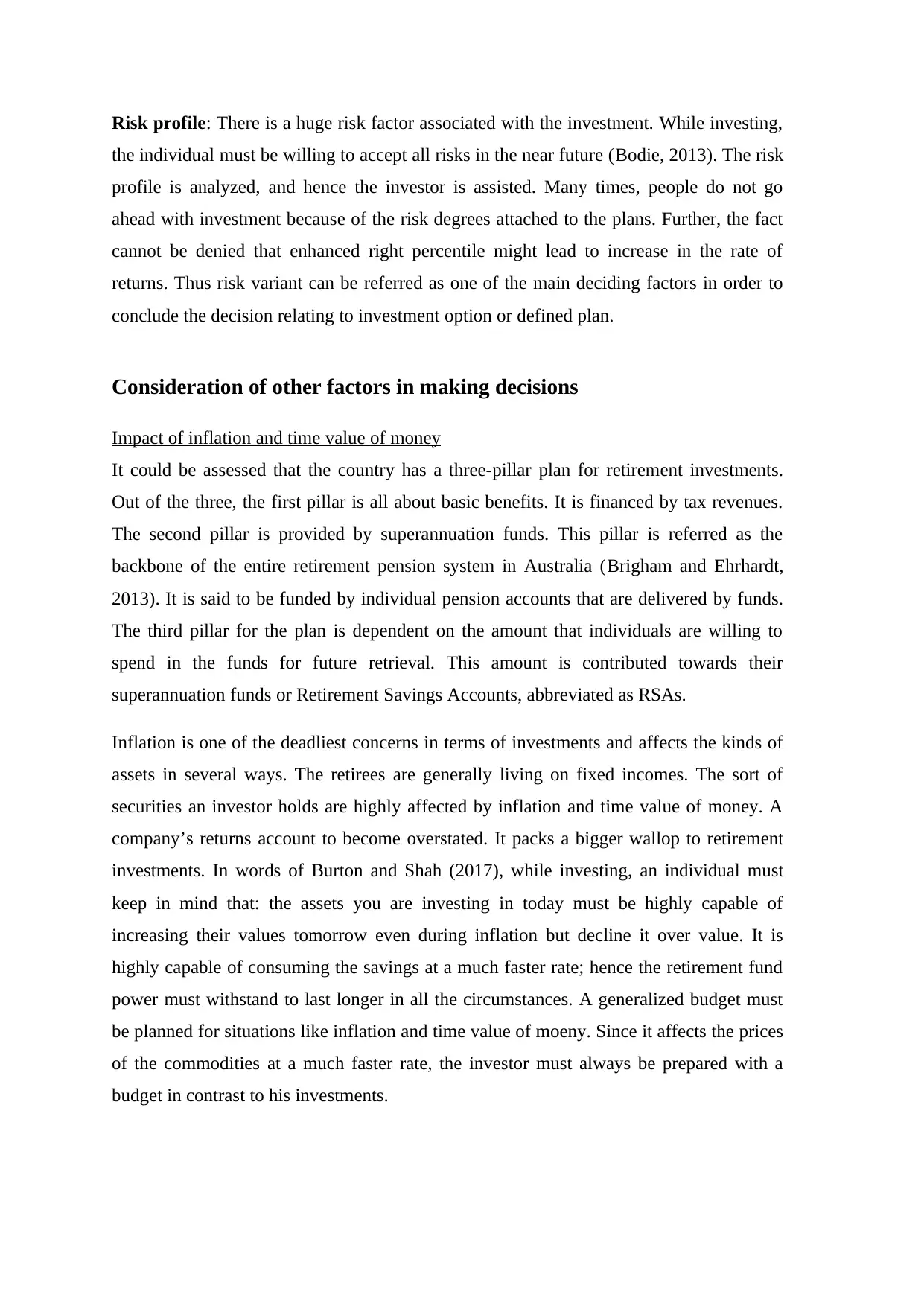
Risk profile: There is a huge risk factor associated with the investment. While investing,
the individual must be willing to accept all risks in the near future (Bodie, 2013). The risk
profile is analyzed, and hence the investor is assisted. Many times, people do not go
ahead with investment because of the risk degrees attached to the plans. Further, the fact
cannot be denied that enhanced right percentile might lead to increase in the rate of
returns. Thus risk variant can be referred as one of the main deciding factors in order to
conclude the decision relating to investment option or defined plan.
Consideration of other factors in making decisions
Impact of inflation and time value of money
It could be assessed that the country has a three-pillar plan for retirement investments.
Out of the three, the first pillar is all about basic benefits. It is financed by tax revenues.
The second pillar is provided by superannuation funds. This pillar is referred as the
backbone of the entire retirement pension system in Australia (Brigham and Ehrhardt,
2013). It is said to be funded by individual pension accounts that are delivered by funds.
The third pillar for the plan is dependent on the amount that individuals are willing to
spend in the funds for future retrieval. This amount is contributed towards their
superannuation funds or Retirement Savings Accounts, abbreviated as RSAs.
Inflation is one of the deadliest concerns in terms of investments and affects the kinds of
assets in several ways. The retirees are generally living on fixed incomes. The sort of
securities an investor holds are highly affected by inflation and time value of money. A
company’s returns account to become overstated. It packs a bigger wallop to retirement
investments. In words of Burton and Shah (2017), while investing, an individual must
keep in mind that: the assets you are investing in today must be highly capable of
increasing their values tomorrow even during inflation but decline it over value. It is
highly capable of consuming the savings at a much faster rate; hence the retirement fund
power must withstand to last longer in all the circumstances. A generalized budget must
be planned for situations like inflation and time value of moeny. Since it affects the prices
of the commodities at a much faster rate, the investor must always be prepared with a
budget in contrast to his investments.
the individual must be willing to accept all risks in the near future (Bodie, 2013). The risk
profile is analyzed, and hence the investor is assisted. Many times, people do not go
ahead with investment because of the risk degrees attached to the plans. Further, the fact
cannot be denied that enhanced right percentile might lead to increase in the rate of
returns. Thus risk variant can be referred as one of the main deciding factors in order to
conclude the decision relating to investment option or defined plan.
Consideration of other factors in making decisions
Impact of inflation and time value of money
It could be assessed that the country has a three-pillar plan for retirement investments.
Out of the three, the first pillar is all about basic benefits. It is financed by tax revenues.
The second pillar is provided by superannuation funds. This pillar is referred as the
backbone of the entire retirement pension system in Australia (Brigham and Ehrhardt,
2013). It is said to be funded by individual pension accounts that are delivered by funds.
The third pillar for the plan is dependent on the amount that individuals are willing to
spend in the funds for future retrieval. This amount is contributed towards their
superannuation funds or Retirement Savings Accounts, abbreviated as RSAs.
Inflation is one of the deadliest concerns in terms of investments and affects the kinds of
assets in several ways. The retirees are generally living on fixed incomes. The sort of
securities an investor holds are highly affected by inflation and time value of money. A
company’s returns account to become overstated. It packs a bigger wallop to retirement
investments. In words of Burton and Shah (2017), while investing, an individual must
keep in mind that: the assets you are investing in today must be highly capable of
increasing their values tomorrow even during inflation but decline it over value. It is
highly capable of consuming the savings at a much faster rate; hence the retirement fund
power must withstand to last longer in all the circumstances. A generalized budget must
be planned for situations like inflation and time value of moeny. Since it affects the prices
of the commodities at a much faster rate, the investor must always be prepared with a
budget in contrast to his investments.
⊘ This is a preview!⊘
Do you want full access?
Subscribe today to unlock all pages.

Trusted by 1+ million students worldwide
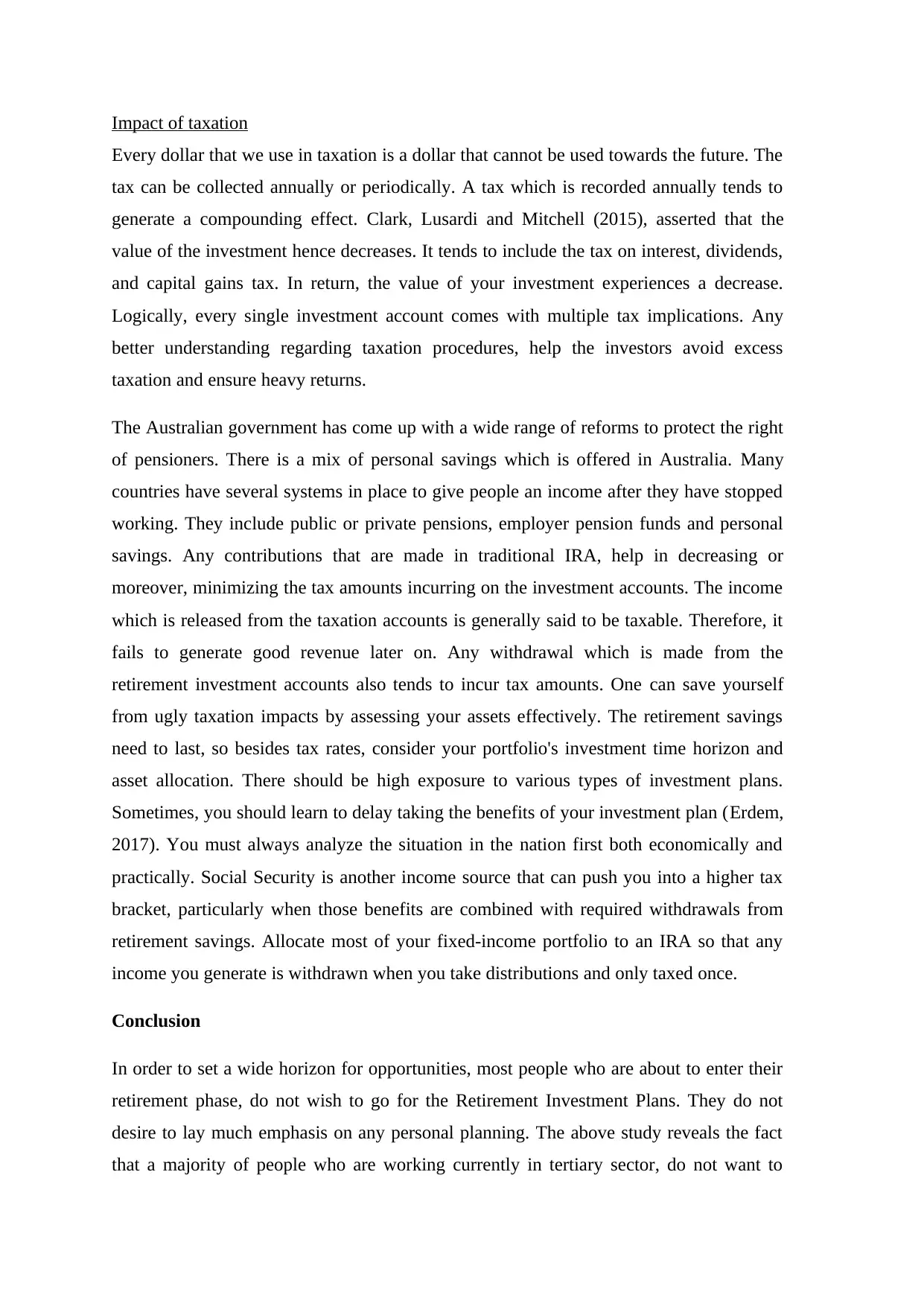
Impact of taxation
Every dollar that we use in taxation is a dollar that cannot be used towards the future. The
tax can be collected annually or periodically. A tax which is recorded annually tends to
generate a compounding effect. Clark, Lusardi and Mitchell (2015), asserted that the
value of the investment hence decreases. It tends to include the tax on interest, dividends,
and capital gains tax. In return, the value of your investment experiences a decrease.
Logically, every single investment account comes with multiple tax implications. Any
better understanding regarding taxation procedures, help the investors avoid excess
taxation and ensure heavy returns.
The Australian government has come up with a wide range of reforms to protect the right
of pensioners. There is a mix of personal savings which is offered in Australia. Many
countries have several systems in place to give people an income after they have stopped
working. They include public or private pensions, employer pension funds and personal
savings. Any contributions that are made in traditional IRA, help in decreasing or
moreover, minimizing the tax amounts incurring on the investment accounts. The income
which is released from the taxation accounts is generally said to be taxable. Therefore, it
fails to generate good revenue later on. Any withdrawal which is made from the
retirement investment accounts also tends to incur tax amounts. One can save yourself
from ugly taxation impacts by assessing your assets effectively. The retirement savings
need to last, so besides tax rates, consider your portfolio's investment time horizon and
asset allocation. There should be high exposure to various types of investment plans.
Sometimes, you should learn to delay taking the benefits of your investment plan (Erdem,
2017). You must always analyze the situation in the nation first both economically and
practically. Social Security is another income source that can push you into a higher tax
bracket, particularly when those benefits are combined with required withdrawals from
retirement savings. Allocate most of your fixed-income portfolio to an IRA so that any
income you generate is withdrawn when you take distributions and only taxed once.
Conclusion
In order to set a wide horizon for opportunities, most people who are about to enter their
retirement phase, do not wish to go for the Retirement Investment Plans. They do not
desire to lay much emphasis on any personal planning. The above study reveals the fact
that a majority of people who are working currently in tertiary sector, do not want to
Every dollar that we use in taxation is a dollar that cannot be used towards the future. The
tax can be collected annually or periodically. A tax which is recorded annually tends to
generate a compounding effect. Clark, Lusardi and Mitchell (2015), asserted that the
value of the investment hence decreases. It tends to include the tax on interest, dividends,
and capital gains tax. In return, the value of your investment experiences a decrease.
Logically, every single investment account comes with multiple tax implications. Any
better understanding regarding taxation procedures, help the investors avoid excess
taxation and ensure heavy returns.
The Australian government has come up with a wide range of reforms to protect the right
of pensioners. There is a mix of personal savings which is offered in Australia. Many
countries have several systems in place to give people an income after they have stopped
working. They include public or private pensions, employer pension funds and personal
savings. Any contributions that are made in traditional IRA, help in decreasing or
moreover, minimizing the tax amounts incurring on the investment accounts. The income
which is released from the taxation accounts is generally said to be taxable. Therefore, it
fails to generate good revenue later on. Any withdrawal which is made from the
retirement investment accounts also tends to incur tax amounts. One can save yourself
from ugly taxation impacts by assessing your assets effectively. The retirement savings
need to last, so besides tax rates, consider your portfolio's investment time horizon and
asset allocation. There should be high exposure to various types of investment plans.
Sometimes, you should learn to delay taking the benefits of your investment plan (Erdem,
2017). You must always analyze the situation in the nation first both economically and
practically. Social Security is another income source that can push you into a higher tax
bracket, particularly when those benefits are combined with required withdrawals from
retirement savings. Allocate most of your fixed-income portfolio to an IRA so that any
income you generate is withdrawn when you take distributions and only taxed once.
Conclusion
In order to set a wide horizon for opportunities, most people who are about to enter their
retirement phase, do not wish to go for the Retirement Investment Plans. They do not
desire to lay much emphasis on any personal planning. The above study reveals the fact
that a majority of people who are working currently in tertiary sector, do not want to
Paraphrase This Document
Need a fresh take? Get an instant paraphrase of this document with our AI Paraphraser
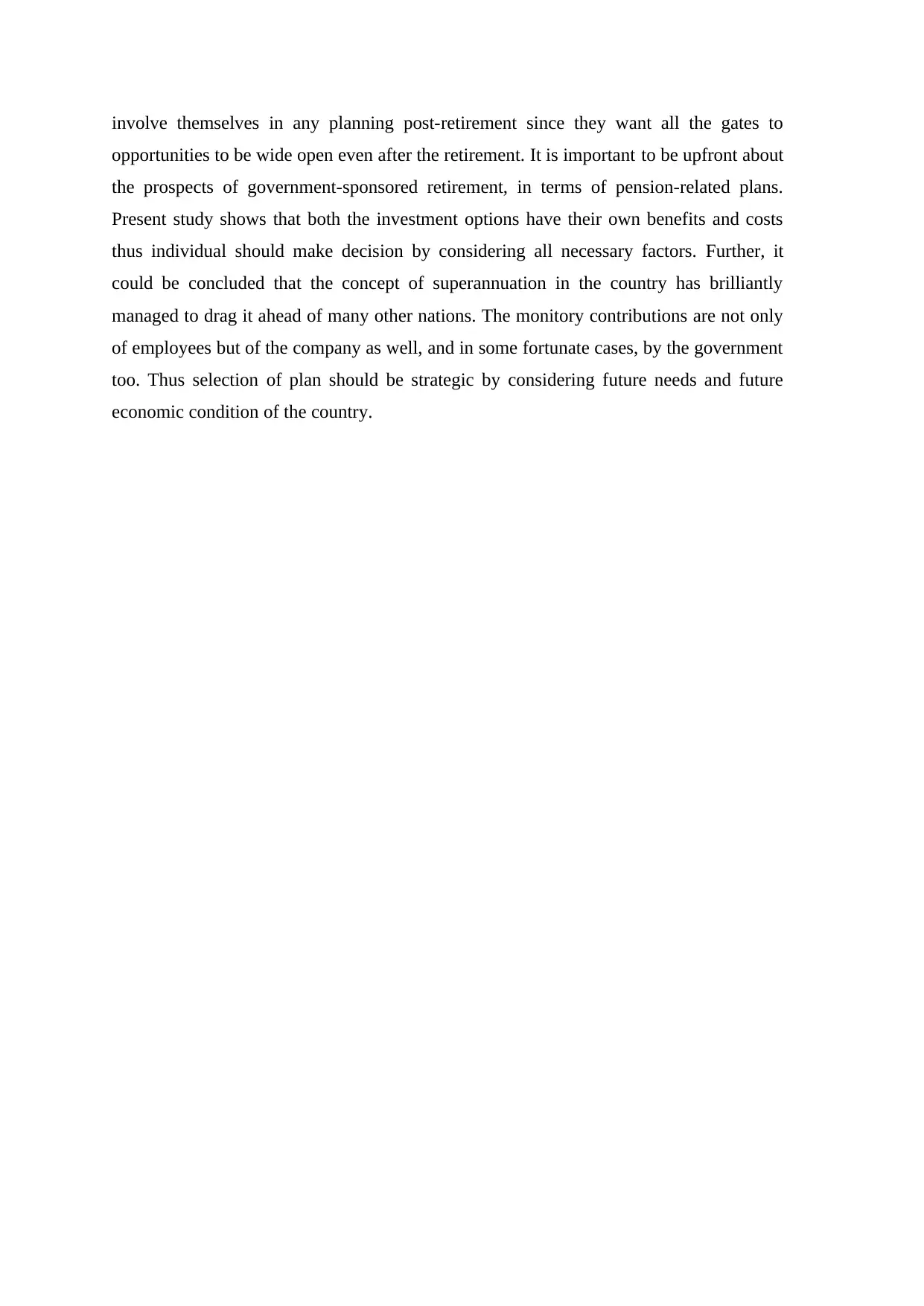
involve themselves in any planning post-retirement since they want all the gates to
opportunities to be wide open even after the retirement. It is important to be upfront about
the prospects of government-sponsored retirement, in terms of pension-related plans.
Present study shows that both the investment options have their own benefits and costs
thus individual should make decision by considering all necessary factors. Further, it
could be concluded that the concept of superannuation in the country has brilliantly
managed to drag it ahead of many other nations. The monitory contributions are not only
of employees but of the company as well, and in some fortunate cases, by the government
too. Thus selection of plan should be strategic by considering future needs and future
economic condition of the country.
opportunities to be wide open even after the retirement. It is important to be upfront about
the prospects of government-sponsored retirement, in terms of pension-related plans.
Present study shows that both the investment options have their own benefits and costs
thus individual should make decision by considering all necessary factors. Further, it
could be concluded that the concept of superannuation in the country has brilliantly
managed to drag it ahead of many other nations. The monitory contributions are not only
of employees but of the company as well, and in some fortunate cases, by the government
too. Thus selection of plan should be strategic by considering future needs and future
economic condition of the country.
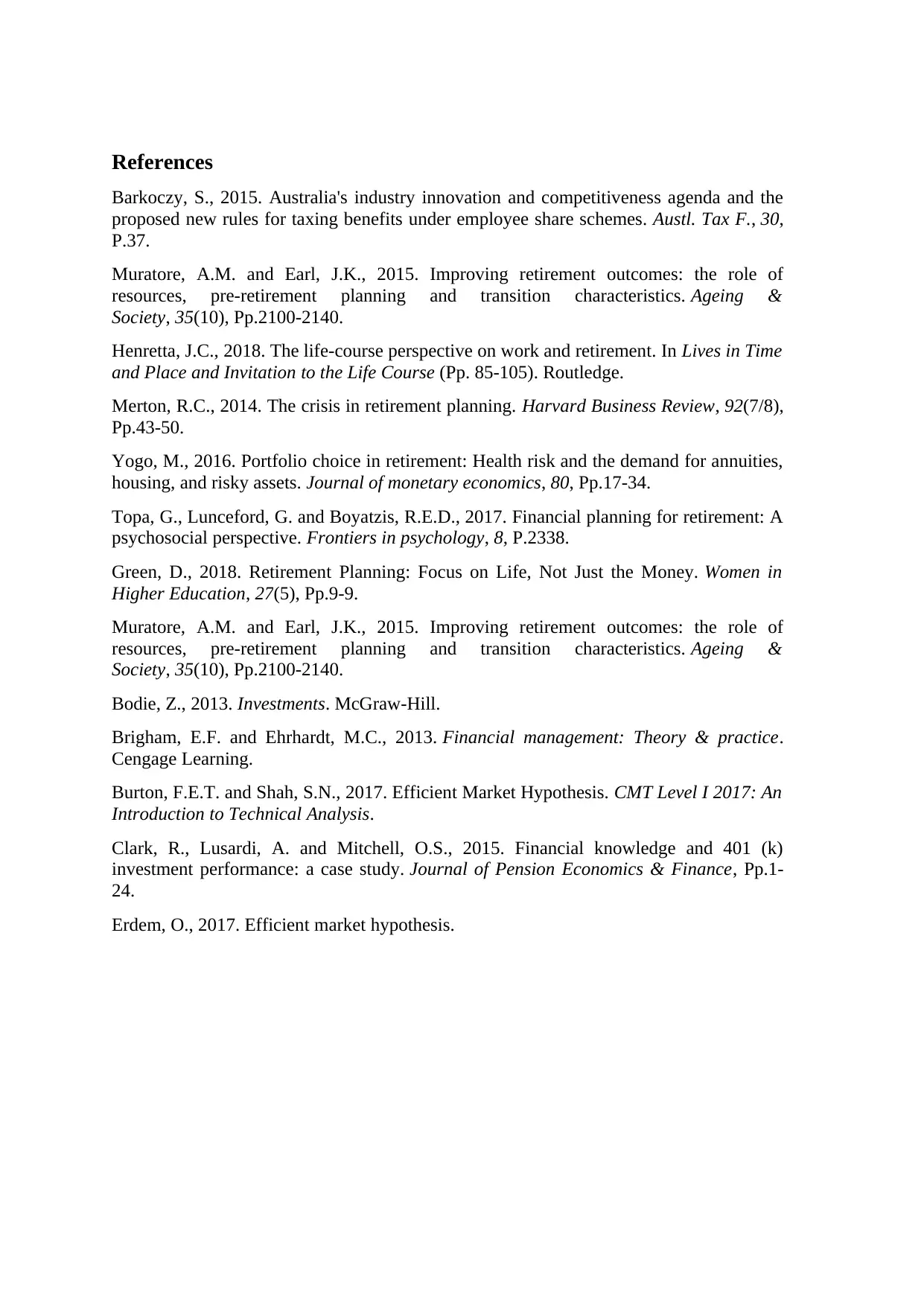
References
Barkoczy, S., 2015. Australia's industry innovation and competitiveness agenda and the
proposed new rules for taxing benefits under employee share schemes. Austl. Tax F., 30,
P.37.
Muratore, A.M. and Earl, J.K., 2015. Improving retirement outcomes: the role of
resources, pre-retirement planning and transition characteristics. Ageing &
Society, 35(10), Pp.2100-2140.
Henretta, J.C., 2018. The life-course perspective on work and retirement. In Lives in Time
and Place and Invitation to the Life Course (Pp. 85-105). Routledge.
Merton, R.C., 2014. The crisis in retirement planning. Harvard Business Review, 92(7/8),
Pp.43-50.
Yogo, M., 2016. Portfolio choice in retirement: Health risk and the demand for annuities,
housing, and risky assets. Journal of monetary economics, 80, Pp.17-34.
Topa, G., Lunceford, G. and Boyatzis, R.E.D., 2017. Financial planning for retirement: A
psychosocial perspective. Frontiers in psychology, 8, P.2338.
Green, D., 2018. Retirement Planning: Focus on Life, Not Just the Money. Women in
Higher Education, 27(5), Pp.9-9.
Muratore, A.M. and Earl, J.K., 2015. Improving retirement outcomes: the role of
resources, pre-retirement planning and transition characteristics. Ageing &
Society, 35(10), Pp.2100-2140.
Bodie, Z., 2013. Investments. McGraw-Hill.
Brigham, E.F. and Ehrhardt, M.C., 2013. Financial management: Theory & practice.
Cengage Learning.
Burton, F.E.T. and Shah, S.N., 2017. Efficient Market Hypothesis. CMT Level I 2017: An
Introduction to Technical Analysis.
Clark, R., Lusardi, A. and Mitchell, O.S., 2015. Financial knowledge and 401 (k)
investment performance: a case study. Journal of Pension Economics & Finance, Pp.1-
24.
Erdem, O., 2017. Efficient market hypothesis.
Barkoczy, S., 2015. Australia's industry innovation and competitiveness agenda and the
proposed new rules for taxing benefits under employee share schemes. Austl. Tax F., 30,
P.37.
Muratore, A.M. and Earl, J.K., 2015. Improving retirement outcomes: the role of
resources, pre-retirement planning and transition characteristics. Ageing &
Society, 35(10), Pp.2100-2140.
Henretta, J.C., 2018. The life-course perspective on work and retirement. In Lives in Time
and Place and Invitation to the Life Course (Pp. 85-105). Routledge.
Merton, R.C., 2014. The crisis in retirement planning. Harvard Business Review, 92(7/8),
Pp.43-50.
Yogo, M., 2016. Portfolio choice in retirement: Health risk and the demand for annuities,
housing, and risky assets. Journal of monetary economics, 80, Pp.17-34.
Topa, G., Lunceford, G. and Boyatzis, R.E.D., 2017. Financial planning for retirement: A
psychosocial perspective. Frontiers in psychology, 8, P.2338.
Green, D., 2018. Retirement Planning: Focus on Life, Not Just the Money. Women in
Higher Education, 27(5), Pp.9-9.
Muratore, A.M. and Earl, J.K., 2015. Improving retirement outcomes: the role of
resources, pre-retirement planning and transition characteristics. Ageing &
Society, 35(10), Pp.2100-2140.
Bodie, Z., 2013. Investments. McGraw-Hill.
Brigham, E.F. and Ehrhardt, M.C., 2013. Financial management: Theory & practice.
Cengage Learning.
Burton, F.E.T. and Shah, S.N., 2017. Efficient Market Hypothesis. CMT Level I 2017: An
Introduction to Technical Analysis.
Clark, R., Lusardi, A. and Mitchell, O.S., 2015. Financial knowledge and 401 (k)
investment performance: a case study. Journal of Pension Economics & Finance, Pp.1-
24.
Erdem, O., 2017. Efficient market hypothesis.
⊘ This is a preview!⊘
Do you want full access?
Subscribe today to unlock all pages.

Trusted by 1+ million students worldwide
1 out of 9
Related Documents
Your All-in-One AI-Powered Toolkit for Academic Success.
+13062052269
info@desklib.com
Available 24*7 on WhatsApp / Email
![[object Object]](/_next/static/media/star-bottom.7253800d.svg)
Unlock your academic potential
Copyright © 2020–2025 A2Z Services. All Rights Reserved. Developed and managed by ZUCOL.




